#food supply
Text
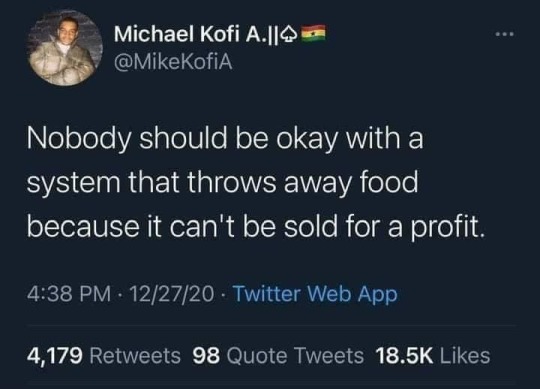
8K notes
·
View notes
Text
"If you control the food, you control the people. That's ultimately the end goal."
All around the world, unelected globalist bodies like the WEF and UN are waging war against farmers, in an attempt to seize control of the global food supply, under the banner of UN Agenda 2030—as detailed in a must-watch new documentary titled 'No Farmers, No Food: Will You Eat The Bugs?' 🤔
#pay attention#educate yourselves#educate yourself#knowledge is power#reeducate yourself#reeducate yourselves#think about it#think for yourselves#think for yourself#do your homework#do some research#do your own research#ask yourself questions#question everything#climate crisis#climate change#totalitarianism#socialism#government corruption#food supply#food shortages
494 notes
·
View notes
Text
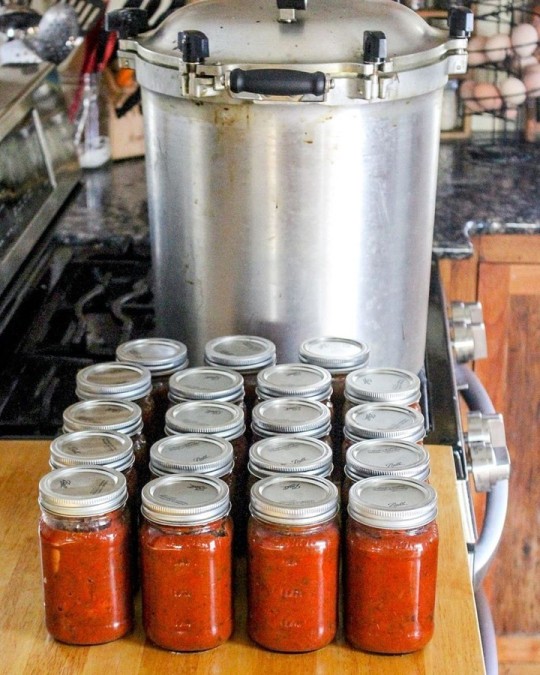
42 notes
·
View notes
Note
I've seen a handful of people speculate that if Jon is truly alive (assuming that the wounds he received at the end of his chapter in ADWD were fatal to begin with), he could maybe inform the Vale of the ongoing food problem at the Wall and therefore, Sansa (or rather "Alayne" in this case) would receive that message and maybe try to reunite with Jon in some way. It sounds a bit wishy washy to me... Do you think that theory holds any merit?
Hi there!
Well, GRRM made very sure to explicitly state that the Vale is sitting on a big food surplus in his TWOW Alayne sample chapter, and that Littlefinger is pressing certain lords to hoard it in order to drive up potential profits in the future and weaken his political opponents.
And while GRRM also made sure in ADWD to emphasize the dire food situation in both the Riverlands and at the Wall, it is only Jon who actually connects this to the Vale in his thoughts:
Our best hope may be the Eyrie. The Vale of Arryn was famously fertile and had gone untouched during the fighting.
(ADWD, Jon IV)
He then proceeds to show us Jon negotiating for a loan with the Iron Bank and collecting (meagre) funds from the wildlings as part of the agreement to let them pass the Wall.
Bowen Marsh sighed. "If they do not slay us with their swords, they will do so with their mouths. Pray, how does the lord commander propose to feed Tormund and his thousands?"
Jon had anticipated that question. "Through Eastwatch. We will bring in food by ship, as much as might be required. From the riverlands and the stormlands and the Vale of Arryn, from Dorne and the Reach, across the narrow sea from the Free Cities."
"And this food will be paid for … how, if I may ask?"
With gold, from the Iron Bank of Braavos, Jon might have replied. Instead he said, "I have agreed that the free folk may keep their furs and pelts. They will need those for warmth when winter comes. All other wealth they must surrender. Gold and silver, amber, gemstones, carvings, anything of value. We will ship it all across the narrow sea to be sold in the Free Cities."
(ADWD, Jon XI)
(Jon. Why. Not. Tell. Him.???)
So GRRM obviously sets up the idea of money procured for the Watch in order to buy food, and food sitting by waiting to be bought in the Vale.
There are complications, of course: Jon's stabbing and potential loss of direct political influence in the North (at least for a while), the uncertainty of the loan going through given Tycho is still roaming around the North, Littlefinger's desire for maximum profit, alternative needs for the food such as the Vale's own starving wildlings which are the mountain clans....
But the connection is obviously there.
I doubt it will be handled as neatly as (recovered) Jon asking and them selling. Much more likely, it is Sansa herself who will try and forge a connection between the North and these food stores GRRM took so much care to inform us of through her POV. The bread riots in KL would have left a lasting impression, and there is the imagery of food used both to tempt her (wine, lemon cakes, pomegranates) and to depict her rejection of Tyrion:
He wanted something from her, but Sansa did not know what it was. He looks like a starving child, but I have no food to give him. Why won't he leave me be?
(ASOS, Sansa IV)
(She ends up serving him overcooked peas during tense and unpleasant dinners.)
What happens when there is food and there are recipients she very much wants to feed, after reuniting with Jon and learning the true extent of the plight of her people?
It may be that Sansa herself will be pressured to pay a high price for that Vale food if she wants it to go North. Whether she ends up having to pay it, is a different matter, but it would absolutely set up a nice mirror between Jon and Sansa in the North toward Joffrey and Margaery in King's Landing, when she arrived with the bounty of the Reach to feed the cheering people - who had been starving due to her own family's blockade of the food supply in the first place. The dark irony of that might be turned on its head. A starving North, a princess with the key to their survival, hard choices, high drama.
49 notes
·
View notes
Text
By George Monbiot
The Guardian
July 15, 2023
Climate breakdown and crop losses threaten our survival, but the ultra-rich find ever more creative ways to maintain the status quo
According to Google’s news search, the media has run more than 10,000 stories this year about Phillip Schofield, the British television presenter who resigned over an affair with a younger colleague. Google also records a global total of five news stories about a scientific paper published last week, showing that the chances of simultaneous crop losses in the world’s major growing regions, caused by climate breakdown, appear to have been dangerously underestimated. In mediaworld, a place that should never be confused with the real world, celebrity gossip is thousands of times more important than existential risk.
The new paper explores the impacts on crop production when meanders in the jet stream (Rossby waves) become stuck. Stuck patterns cause extreme weather. To put it crudely, if you live in the northern hemisphere and a kink in the jet stream (the band of strong winds a few miles above the Earth’s surface at mid-latitudes) is stuck to the south of you, your weather is likely to be cold and wet. If it’s stuck to the north of you, you’re likely to suffer escalating heat and drought.
In both cases, the stuck weather, exacerbated by global heating, affects crops. With certain meander patterns, several of the northern hemisphere’s major growing regions – such as western North America, Europe, India and east Asia – could be exposed to extreme weather at the same time, hammering their harvests. We rely for our subsistence on global smoothing: if there’s a bad harvest in one region, it’s likely to be counteracted by good harvests elsewhere. Even small crop losses occurring simultaneously present what the paper calls “systemic risk”.
Already, regional climate shocks have helped cause a disastrous reversal in the trend of global chronic hunger. For many years, the number of hungry people fell. But in 2015 the trend turned and has been curving upwards since. This is not because of a lack of food. The most likely explanation is that the global food system has lost its resilience. When complex systems lose resilience, instead of damping the shocks that hit them, they tend to amplify them. The shocks amplified across the system so far have landed most heavily on poor nations that depend on imports, causing local price spikes even when global food prices were low.
If this happens when harvests are affected in just one country or one region, we can only imagine the results if extreme weather simultaneously hits several major growing regions.
Other papers have been published with similar themes, showing, for example, the impacts of the rising frequency of “flash droughts” and concurrent heatwaves in grain-producing regions, and how global heating hits food security. All have been largely or entirely ignored by the media.
We face an epochal, unthinkable prospect: of perhaps the two greatest existential threats – environmental breakdown and food system failure – converging, as one triggers the other.
There are plenty of signs, some of which I’ve tried to explain in the Guardian and, with a sense of rising urgency, in a presentation to parliament, suggesting that the global food system may not be far from its tipping point, for structural reasons similar to those that tanked the financial sector in 2008. As a system approaches a critical threshold, it’s impossible to say which external shock could push it over. Once a system has become fragile, and its resilience is not restored, it’s not a matter of if and how, but when.
So why isn’t this all over the front pages? Why, when governments know we’re facing existential risk, do they fail to act? Why is the Biden administration allowing enough oil and gas drilling to bust the US carbon budget five times over? Why is the UK government scrapping the £11.6bn international climate fund it promised? Why has Labour postponed its £28bn green prosperity fund, while Keir Starmer is reported to have remarked last week “I hate tree huggers” (a pejorative term for environmental campaigners)? Why are the Sun, the Mail, the Telegraph and the Express competing to attack every green solution that might help to prevent climate chaos? Why does everything else seem more important?
The underlying problem isn’t hard to grasp: governments have failed to break what the economist Thomas Piketty calls the patrimonial spiral of wealth accumulation. As a result, the rich have become ever richer, a process that seems to be accelerating. In 2021, for example, the ultra-rich captured almost two-thirds of all the world’s new wealth. Their share of national income in the UK has almost doubled since 1980, while in the US it’s higher than it was in 1820.
The richer a fraction of society becomes, the greater its political power, and the more extreme the demands it makes. The problem is summarized in one sentence in the resignation letter of the UK environment minister Zac Goldsmith: instead of attending a crucial environment summit, Rishi Sunak went to Rupert Murdoch’s summer party. We cannot work together to solve our common problems when great power is in the hands of so few.
What the ultra-rich want is to sustain and extend the economic system that put them where they are. The more they have to lose, the more creative their strategies become. As well as the traditional approach of buying media outlets and pouring money into the political parties that favour them, they devise new ways of protecting their interests.
Corporations and oligarchs with massive fortunes can hire as many junktanks (so-called thinktanks), troll farms, marketing gurus, psychologists and micro-targeters as they need to devise justifications and to demonise, demoralise, abuse and threaten people trying to sustain a habitable planet. The junktanks devise new laws to stifle protest, implemented by politicians funded by the same plutocratic class.
It could scarcely be more screwed up. The effort to protect Earth systems and the human systems that depend on them is led by people working at the margins with tiny resources, while the richest and most powerful use every means at their disposal to stop them. Can you imagine, in decades to come, trying to explain this to your children?
Looking back on previous human calamities, all of which will be dwarfed by this, you find yourself repeatedly asking “why didn’t they … ?” The answer is power: the power of a few to countermand the interests of humanity. The struggle to avert systemic failure is the struggle between democracy and plutocracy. It always has been, but the stakes are now higher than ever.
64 notes
·
View notes
Text

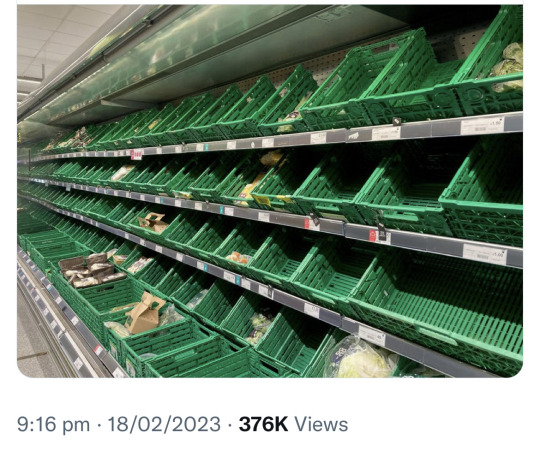
49 notes
·
View notes
Link
“Right now, during the winter months, you milk quite a bit more milk because the feed is very consistent. And if you do a good job, you will produce quite a bit of milk. But right now, we’re over our quota, and it’s regulated by the government, and [implemented] by the DFO,” said Human.
“Look at this milk running away. It’s the end of the month [and] I dump 30,000 liters of milk and it breaks my heart. This year Canadian milk is $7 a liter.”

“This is a great example on how they control food supplies to the benefit of the government and corporations at the cost to the people. They do not care about you what so ever. Great example of how the government isn’t for the people and is doing more harm than good. Pure evil.”


#Food Supply#Canada#Dictator Trudeau's#Dairy Supplies#CONTROL CONTROL#Wake Up#Before its 2 LATE !!#MUST SEE VIDEO
46 notes
·
View notes
Text
"Protecting Our Food Supply: The Importance of World Bee Day"
"Happy World Bee Day! Let's protect these vital pollinators and ensure a healthy and sustainable future for our food supply and environment. #WorldBeeDay #Pollinators #Biodiversity"
This past Saturday, May 20, 2023, was the observance of World Bee Day. We should take the time to acknowledge the benefits and the importance of these tiny workers and recognize their vital role to the survival all life on this planet! Everyday is World Bee Day!
Rod W
World Bee Day is celebrated annually on May 20th to raise awareness about the importance of bees and other pollinators for our…
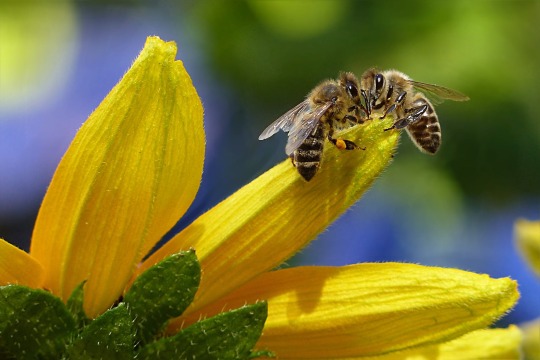
View On WordPress
#Bees#Biodiversity#conservation#ecosystem#food supply#habitat loss#pesticides#pollinators#sustainable farming#World Bee Day
21 notes
·
View notes
Text
Reforming the world’s food systems will be a key step in limiting global temperature rises, the UN has said, as it set out the first instalment of a roadmap for providing food and farming while staying within 1.5C.
Food production is highly vulnerable to the effects of the climate crisis, with research suggesting that as much as a third of global food could be at risk from global heating.
Agriculture and livestock farming are also major sources of greenhouse gas emissions, contributing roughly a 10th of global carbon output directly, and more than double that if the conversion of natural habitat to farming is included.
Until now, however, the UN has held back from setting out in detail how the world can both meet the nutritional needs of a growing population, which is forecast to reach 10 billion by 2050, and reduce global greenhouse gases to net zero by the same date. The latter is required to limit global temperature rises to 1.5C above pre-industrial levels.
Maximo Torero, the chief economist for the Food and Agriculture Organisation (FAO), told the Guardian: “We need to act to reduce hunger, and to stay within 1.5C. This is about rebalancing global food systems.”
The roadmap will be laid out over the next two to three years, starting with a document published at Cop28 in Dubai that contains 20 key targets to be met between 2025 and 2050, but little detail on how they can be met. Further detail on how the aspirations can be achieved will be set out in future instalments at the next two Cop summits.
The targets include: reducing methane emissions from livestock by 25% by 2030; ensuring all the world’s fisheries are sustainably managed by 2030; safe and affordable drinking water for all by 2030; halving food waste by 2030; eliminating the use of traditional biomass for cooking by 2030.
Torero said the plan would not include calls for a meat tax, which some experts have advocated, but would examine measures to tax sugar, salt and super-processed foods, and better food labelling.
More climate finance should be devoted to agriculture, he added, which accounts for only about 4% of climate finance today. He also called for much more efficient use of agricultural land and resources.
Emile Frison, an expert at IPES-Food (the International Panel of Experts on Sustainable Food Systems), said: “The FAO should be applauded for this first step in laying out a plan to eliminate extreme hunger and the third of greenhouse gases that come from food systems, and particularly for its emphasis on a just transition – it is not easy.”
But he said the plan did not go far enough. “This current draft puts a huge emphasis on incremental changes to the current industrial food system. But this is a flawed system that is wrecking nature, polluting the environment, and starving millions of people,” he said. “These efficiency-first proposals are unlikely to be enough to get us off the high-pollution, high-fossil-fuel, high-hunger track we are on.”
He called for more radical proposals in the coming instalments. “The next rounds of this process will need to go much further in proposing a real transformation of the status quo, by putting much more emphasis on diversification, shorter supply chains and agroecology, and on tackling the massive power inequalities imposed by a handful of companies that define what we grow and eat.”
Ruth Davis, a fellow at the European Climate Foundation, and senior associate at Oxford’s Smith School, said: “The world desperately needs a roadmap which points us to a fairer, more resilient and sustainable future for food systems. The FAO has made a useful start but it doesn’t take us all the way to the destination we need."
4 notes
·
View notes
Text
35 notes
·
View notes
Photo
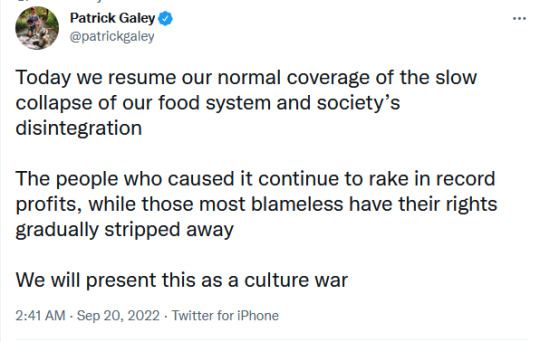
#tweet#tweets#twitter#culture war#cultural critique#cultural criticism#Society and Culture#food supply chain#food supply#climate crisis#climate change
46 notes
·
View notes
Text
This 👆 is disturbing.🤔
#pay attention#educate yourself#educate yourselves#wake the fuck up#wake up#wake up america#wake up people#wake up world#do your own research#do your research#do some research#do your homework#exposing the truth#think about it#think for yourself#think for yourselves#be ready#be prepared#food industry#food supply#food shortages#dark winter#human experimentation#exposing evil#exposing lies#exposing corruption#government tyranny#government lies#government corruption
14 notes
·
View notes
Text
"If you control the food, you control the people. That's ultimately the end goal." 👀
All around the world, unelected globalist bodies like the UN and WEF are waging war against farmers, in an attempt to seize control of the global food supply, under the banner of UN Agenda 2030.
Are You Prepared? 🤔
#pay attention#educate yourselves#educate yourself#knowledge is power#reeducate yourself#reeducate yourselves#think for yourselves#think about it#think for yourself#do your homework#do some research#do your own research#ask yourself questions#question yourself#question everything#be ready#be prepared#food shortages#food supply#food supply chain
707 notes
·
View notes
Text
PUSH AND PULL STRATEGY IN SUPPLY CHAIN
Grate to Learn
PUSH AND PULL STRATEGY IN SUPPLY CHAIN
#7 - Week 2

Hello everyone, today, I will bring you an interesting topic that I learned on Coursera: Supply Chain Management: Be Global by Dr. Mehrdokht Pournader from Macquarie University.
This series will last for 6 weeks corresponding to the content learned in the course. I will experience and write down what I learn through each subject bilingually. Hopefully, my sharing will help you, especially those interested in Supply Chain!
#7 - Week 2:
A good supply chain manager knows how to use different tactics and understand Trade-offs (lesson #6) in a certain supply chain to help the supply chain achieve balance in terms of value. cost efficiency and responsiveness at all times. One such effective strategy is: Pull and Push strategies focus on Demand Forecast and Align to customer preferences (Suitable to customer needs) through three application examples in the lesson.
Imagine, you are working near a shopping mall, you are on your lunch break and are planning to buy them, what are your options? First, if you are in a hurry, you will choose fast food like a sandwich from the nearest store. Second, if you want to eat more, you can choose to eat sushi at a food court. Third, you can choose a restaurant that you love and choose a plate of steak. As a supply chain manager, think about the differences between the three options above:
Which one has the most impact by logistics and strategies.
Which one belongs to the Market-responsive supply chain?
Which one belongs to the Physically-efficient supply chain?
For the sandwich supply chain, in the manufacturing plant, its production, packaging and distribution are calculated based on long-term forecast of demand. In short, sandwiches are pushed to market based on long-term forecasts. This is called Push strategy or called production method Make-to-stock strategy.
The advantage of this Push strategy is that logistics plans aim at cost efficiency and economies of scale such as purchasing (buying in large quantities will get discounts on products, pickles, side lettuce from farmers), produce and transport large quantities of inventory (full truckload), minimizing inbound and outbound transportation costs.
The disadvantage of the Push strategy is that once customers change their tastes or some other factors change, affecting preferences or changing needs, the supply chain will be very slow to respond to those changes. That change causes significant damage
For the third option, fancy restaurant, preparation and delivery are done after you order from ingredients bought, order placed, prepared and food delivered. They are completely dependent on need,daily forecast and, they are demand-driven. This is called Pull Strategy or Make-to-order strategy.
The advantage of Pull strategy is that production and distribution are based on actual customer needs, final products or final services are personalized. Inventory or in this example other food waste is minimized. By personalizing, we improve quality and customer satisfaction.
The biggest disadvantage of the Pull strategy is that it is difficult to achieve economies of scale, and the cost to complete the final product is often quite high. The challenge is that the delivery speed (lead times) to the end user is often longer, causing customers to wait to get their food instead of choosing a sandwich with almost no wait.
Thus, Push strategy will be suitable for Physically-efficient supply chains and Pull Strategy will be suitable for Market-responsive supply chains.
The question is how can we take advantage of both Pull and Push strategies in the supply chain? The second example of sushi is a Push strategy, but the biggest difference is that you can choose multiple types of sushi, creating custom and delicious sushi plates of your choice according to a Pull strategy. A sushi restaurant needs to synthesize customer demand forecasts, then prepare a certain amount of sushi from each forecast (Aggregated demands). Aggregate forecasts are often more accurate than forecasts for each individual product or service. Sushi restaurants not only ensure and enhance customer satisfaction with personalized sushi plates, but also enjoy cost-effectiveness in aggregate forecasting and benefit from economies of scale. This is called Push Pull Strategy.

Supply chain managers are experts at drawing the line between two strategies based on the speed at which sushi is created and delivered to the final consumer in order to achieve cost-effective, increased responsiveness in the process. supply chain.
See you on topic Supply chain Terms will be very useful for your career in post #8.
Grate To Learn,
#supplychainmanagement#business#gratetolearn#supplychainsolutions#food supply#sushi#sandwich#supplychain
2 notes
·
View notes
Text
5 notes
·
View notes